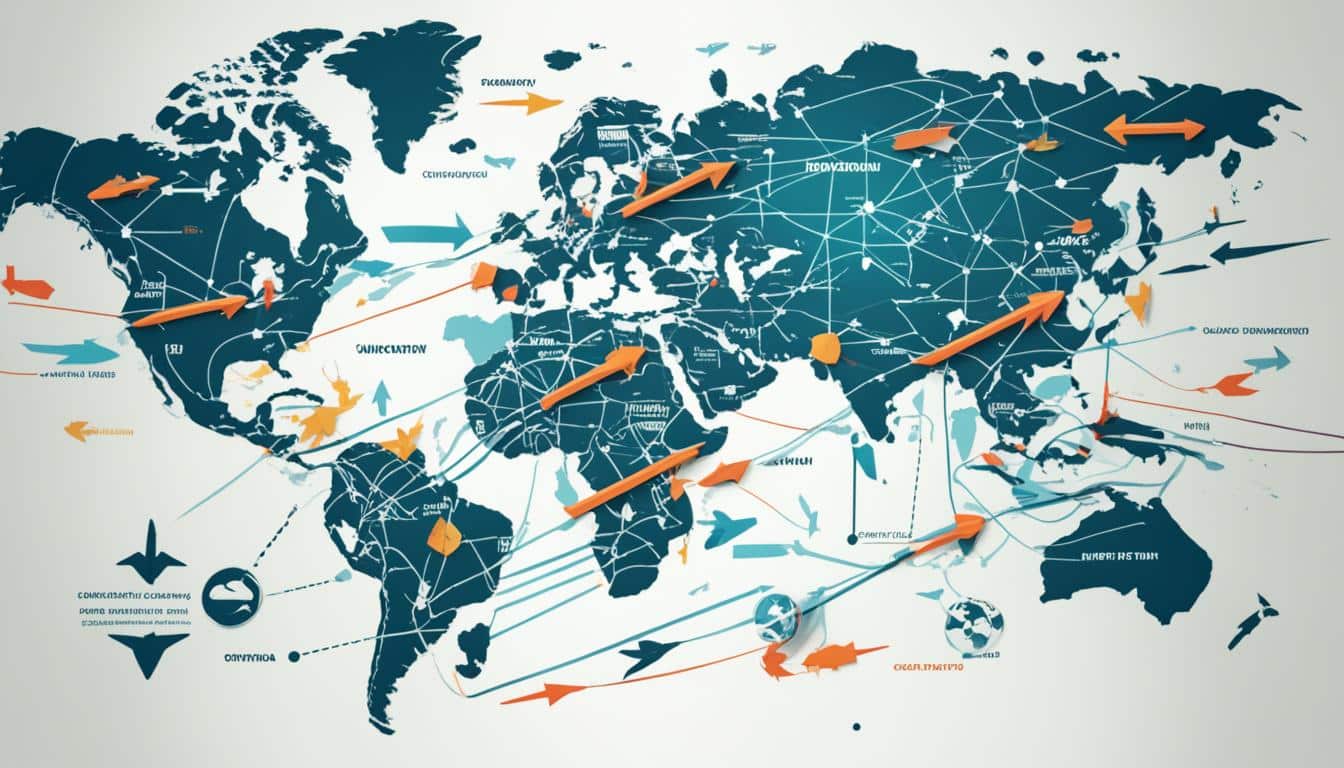Menu

Did you know almost 95% of consumers live outside the United States? This fact shows huge chances for companies expanding to global markets. The Global Trade Guide, split into three parts, addresses these opportunities.
The guide covers legal aspects, documentation, and compliance. It also looks at picking markets, checking trends, and the money side of exporting. This includes budgeting and how to manage risks. It also talks about logistics and today’s digital and small partnership trends. It’s a key map for planning growth in global markets.
For more details, explore the complete guide here.
Starting a successful export market needs a strong base. This base deals with foreign market entry and making sure you meet international rules. Key things here include the legal stuff, paperwork, and financial plans. They are crucial for how well your exports do.
To get into worldwide trading, you need to know the law. This means learning about global rules, checking what your target countries want, and sticking to local laws. Legal details can change a lot depending on the country. So, doing your homework can help you avoid legal problems and fines.
Making exports work smoothly depends on getting the paperwork right. Things like export licenses and import permits are key to moving goods across borders without problems. Keeping up to date with rules and getting your documents ready are essential for an easy start in a new market.
Good financial planning is vital for exporting well. With the right financial management resources, businesses can deal with money changes, know how to enter new markets, and lower money risks. Using strong financial tools helps companies do better in the global market and get ready to export more.
Thorough market research is essential for a strong export plan. You need to check out your target markets carefully. Look at who buys what and trends. And, find out who else is selling there. Doing this helps businesses understand the market better. They can then make smart choices and plan their moves carefully.
It’s key to know which markets to aim for. Smaller companies might focus on 3 to 5 places to start. Look at U.S. export stats to find good markets. And, see what’s in demand globally with foreign import data. Keep an eye on market trends too. This tells you if a market is growing or shrinking.

Knowing who lives in these places and what they can spend helps. Check out the size of the market, income levels, and local products. It’s also good to target places that have special agreements with the U.S. This can make it easier to enter those markets.
Getting to know your competition is crucial. This includes looking at their market share, prices, how they sell, and promote their products. This info is gold. It helps you make a plan. Decide how to step in, who to work with, and what to say about your product.
| Factor | Details |
|---|---|
| Market Size | Evaluated by population and income levels |
| Growth Potential | Assessed through market trends and industry growth |
| Competitive Landscape | Analysis of competitors’ strategies and market share |
| Cultural Considerations | Understanding local behaviours and preferences |
Before diving into global trade, an export readiness assessment is key. This step looks deeply into a business’s internal capabilities and cash flow. It gives insights on getting ready to enter a market successfully.
Assessing your business’s skills and leadership is vital. Research shows firms with less export focus make up 15.4%. This highlights the role of strong management. Knowing how to protect intellectual property is also crucial for global trading.
Having enough money to support exports is a big issue. Looking at your financial strength early on helps handle market entry costs. It also aids in risk management and keeping up business abroad.
Preparing your products for different cultures and laws is a must. It helps you stand out in the global market. It’s also important to know about shipping, customs, and payment options. This is especially true for goods that have strict rules, like military items.
Strong operational plans are critical. They use tools like advertisement cookies and data analysis to support both local and global marketing efforts. Having a solid strategy in place can really boost your chances of international success.
Creating a strong export plan means knowing what you want and tracking your progress. It’s vital to have a deep understanding of every part involved. This makes sure your plan matches your company’s aims well.

To start, you must set clear and measurable goals for your exports. This includes picking the markets to enter, deciding how much to sell, and when to start. With most U.S. exporters only selling to one market, like Canada, clear goals can help them grow. They can tap into new countries, selling more and expanding their reach.
It’s key to pick the right measures to track your export plan’s success. These can be things like how much you sell, your market share, customer growth rates, and profits. With small exporters often selling to many countries, the trend is towards more ‘mini-multinationals.’ Keeping an eye on these KPIs lets you see how well your business adapts.
Planning for exports needs a detailed, careful alignment with your bigger business goals. This means making specific plans that deal with product changes, how to price, advertising, and shipping. Remembering things like export rules, cultural differences, and protecting your brands is also essential. Linking your export aims with the whole company’s strategy helps everyone work together. This makes global growth smoother and boosts how well the business runs.
Focusing on a solid export marketing approach and detailed planning can lead to lasting growth in global markets. Setting clear goals and tracking your progress with the right benchmarks keeps your export efforts on track. This helps strengthen your place worldwide.
Adapting products for global markets is key for any worldwide growth. Markets overseas are so varied that it’s essential to be sensitive to the local culture. This leads to effective product changes for selling abroad.
Localisation strategies and export product customisation are vital for international trade success. They involve changing how products look and adjusting their features. For example, in Japan, detailed packaging is highly valued.
Products may also need redesigning for different electrical standards worldwide. US products, for example, must often adapt to metric measurements. This change might affect the product itself and its manuals.
Being culturally aware in international markets is crucial. Brands like Red Bull, Nike, and Coca-Cola show how to keep a consistent brand. Yet, they change their marketing to connect with diverse people. Ford’s experience in India warns against ignoring local habits and tastes.
Food chains like McDonald’s, Domino’s Pizza, and Dunkin’ Donuts make menu changes for local customers. McDonald’s in India, for example, offers many vegetarian options. It shows an awareness of local culture.
To wrap up, adapting products for export requires a thorough focus on local needs and cultural sensitivity. This ensures not just meeting regulations, but also building wider consumer appeal.
Setting up good distribution channels is vital for entering new markets successfully. Companies should choose their export partners with care. They should also review how they distribute their products. Doing so helps them reach more people and perform better in global markets.

When picking export partners, look at their knowledge, reputation, and covered area. Export intermediaries, like export management or trading companies, can really help. They handle tasks like finding buyers abroad, shipping products, and managing payments. This can take a lot off your plate.
Working with distributors gives you access to their established connections and insights. This is great, especially for companies new to exporting. Distributors might also offer extra services like setup or handling returns. But, remember, you might have to share your profits and give up some control.
When you look at how to distribute, consider all the options. Each business has different needs and goals. Selling directly means you, as the U.S. producer, take care of everything. This gives you more control but requires a lot of time and effort.
Indirect selling uses agents or wholesalers and is more flexible. The rise of cross-border eCommerce shows how big platforms help get closer to customers. They also make distribution easier.
Franchising is yet another route. Here, someone in another country runs things. This promotes a consistent brand and fits well with local markets.
The export strategy you pick really affects how well your products get out there. How big you are, how much risk you can take, and your past export experience all matter. They help choose the best way forward.
Mixing direct with indirect sales can be a smart move. This way, you get to more places and stay flexible. Adding retail stores and wholesale outlets to your mix can also be beneficial.
It’s key to have clear deals, talk often, and report on how things are going. Check that your partners’ services fit your business goals well. Boosting these with strong marketing can improve your distribution. This helps avoid problems that come from weak brand and marketing support.
With the right mix of distribution channels and partners, businesses can make a mark in their target markets. Remember, effective market penetration starts with careful planning and choosing the right partners.
In global trade, getting the price right is key for success. To set prices well, companies need to look at what customers want. They should also consider if people in that place have enough money to buy their products. This is where knowing the average income and how currency values change matters.
We must understand a market’s need by looking at its economy, who lives there, and what they like. Even if people don’t earn a lot, they might want certain products badly. But, changes in the value of money can make these products cost more. So, seeing the big picture helps in choosing the right price for export items.
Finding the right price also means counting all costs of selling abroad. This is not just how much it costs to make a product. It includes taxes, fees at customs, money spent on business trips, and even making products look better for that new market. By adding up all costs, companies can price their goods in a way that lets them make money but also be an attractive choice.
To make sure prices are good, it’s important to know what other sellers are charging. Sometimes, you need to be as cheap or cheaper than others. But in places where there’s not much competition, you might sell for a bit more. This balance of what you sell for and what you make helps companies stay strong in the market for the long run.
| Cost Factors | Impact on Pricing |
|---|---|
| Tariffs and Customs Fees | Increase landed costs significantly |
| Currency Fluctuations | Alters product affordability |
| Market Research Fees | Affects financial feasibility |
| Business Travel Expenses | Contributes to overall cost |
| Product Modifications | Necessary for market adaptability |
Setting the right price for exporting mixes knowing the market, the true costs, and checking what rivals are doing. With this in mind, prices can attract customers and help companies keep making a profit. It’s how they achieve success in selling their products worldwide.
An effective export marketing plan is key to global brand success. It focuses on brand awareness, digital channels, and sales promotions for exports. This strategy helps your brand connect with people worldwide.
To make your brand known in new places, you need to study the target market well. You must use strategies that fit the local culture and consumer habits. Include what your competitors do, how you promote, and change your products or services to fit in.
The aim is to create a unique brand that people from different parts of the world can relate to.
Using digital marketing channels today is a must. They let your brand reach a wide range of people. You can use social media, emails, or content to connect with them.
Creating a good digital strategy means using different methods to reach more people. You should keep an eye on the results and adjust your strategy to do better.

In export markets, both traditional and new sales promotion ways are important. Good marketing campaigns bring attention, make sales, and keep customers coming back. You can use ads, press, and events to promote your brand.
Together, these efforts make your brand more visible and trustworthy. A smart marketing plan makes sure your promotions are not just seen but leave a mark.
| Factors to Consider | Details |
|---|---|
| Target Market Characteristics | Consumer behaviour, cultural influences, and market demand. |
| Competitor Strategies | Analysis of competitor pricing, promotional methods, and market positioning. |
| Promotional Tools | Advertising, trade shows, local partnerships, and press coverage. |
| Product/Service Adaptation | Customization to meet local preferences and regulatory requirements. |
By using all these parts well, an export marketing plan can make your brand a global hit. Carefully planned promotions not only sell more today but also prepare for steady future growth globally.
For companies wanting to go global, mastering export marketing is key. It involves using content marketing, social media, and email marketing. These strategies help businesses reach new markets and connect with people worldwide.
Content marketing is vital in reaching global audiences. It allows businesses to share their unique value with customers. To succeed, companies should create content that meets the needs of different cultures. This means doing thorough research to make sure the content is relevant and helpful.
Social media has billions of potential customers. It’s a powerful tool for businesses. They can use platforms like Facebook and Instagram to connect with people worldwide. A key part of this is adapting strategies to fit different social media sites and cultures.
Email marketing is still very effective for global sales. It helps keep international customers up-to-date with products and promotions. Personalising emails improves how they are received, leading to more sales. Using the right tools makes email marketing more efficient and effective.
When companies combine these marketing tactics, they can enter new markets strongly. Content marketing, social media, and email campaigns help them reach and connect with international audiences. This approach leads to lasting business growth and success.
Good export logistics and distribution management ensure products reach global markets smoothly. This task includes picking the right freight forwarders and improving shipping. It’s also about dealing with customs processes and duties effectively.
It’s key to choose experienced and trustworthy freight forwarders for smooth shipping. They manage everything from transport to paperwork and compliance. With their help, companies get their goods to customers on time and in top shape.

Making shipping efficient is vital, which involves cutting any hurdles. This means knowing the best ways to package, select paths, and choose transport types. Using tech like tracking and monitoring boost how well shipping works.
Dealing with customs is critical in export logistics. It involves a lot of rules and paperwork. So, staying updated on laws and keeping documents in check helps avoid problems. Professional customs brokers can make the process easier.
| Aspect | Importance | Implementation Strategies |
|---|---|---|
| Freight Forwarders | Ensures expertise in handling logistics and documentation | Choose reputable and experienced partners |
| Efficient Shipping | Enhances delivery reliability and customer satisfaction | Implement automated tracking and optimise routes |
| Customs Management | Mitigates risks of delays and financial penalties | Stay updated with regulations and use customs brokers |
For companies wanting to deliver international orders well, effective logistics management is crucial. This involves choosing skilled freight forwarders, making shipping smoother, and being smart with customs. Doing this helps companies keep their distribution strong worldwide.
Getting through the world of international trade is tricky. It needs a deep dive into different laws and standards. Sticking to international regulations compliance is key to dodge fines and earn trust worldwide. Companies need to look at both the rules for importing and exporting, and how they manage their intellectual property.
Knowing import/export regulations well is the first step to follow them. The Export Administration Regulations (EAR) control sending out certain goods, software, and tech. Also, US laws need exporters to tell about shipments worth $2,500 or more or needing a special permit using the AES.
US exporters must follow rules from both America and other countries. This includes coping with taxes from foreign states, which might be less due to trade deals with the US. It’s important to meet local standards, like the EU CE mark, to avoid problems in trade.
Companies also need to handle customs duties, import limits, and how to label products. These rules change between countries. Doing thorough research and working closely with shipping experts is key to keeping goods moving smoothly. This means following all the needed paperwork and checking rules in different countries.
Keeping and managing intellectual property rights is a big part of following the law in trade. Good IP protection helps keep a company’s new ideas and tech safe in the world market. It also means following agreements like the EU GDPR, which takes care of personal data in Europe.
Firms should also know about each place’s own laws on IP, like patents and copyrights. Coming up with strong IP plans helps keep a company’s ideas safe from copying or misuse all around the world.
By getting the hang of international regulations, import/export rules, and intellectual property rights, companies can deal with the legal puzzles and do well globally.
Global trade is full of surprises, needing smart plans to avoid risks. Political changes or new trade barriers can shake up markets. It’s key to be ready to deal with these issues.

Changes in currency values can hurt a company’s profit. Using strategies like hedging can protect you from money swings. It’s also vital to recognise when markets might slow down, so you will know when to boost your efforts.
“Effective cross-border business development relies heavily on a comprehensive understanding of diverse market dynamics and potential cultural risks.”
Different cultures can cause big misunderstandings, which can harm business. Taking time to learn about other cultures helps create strong international bonds. Also, not following local laws or behaving unethically can be very risky. It’s important to always do the right thing and get legal advice when needed.
| Risk Type | Impact | Mitigation Strategy |
|---|---|---|
| Political Risks | Market access and profitability issues | Adaptive measures and policy monitoring |
| Economic Risks | Effect of currency fluctuations, economic downturns | Hedging strategies, market demand analysis |
| Cultural Risks | Misunderstandings, cross-cultural discrepancies | Cultural sensitivity training, cross-cultural competence development |
| Compliance Risks | Legal non-compliance, unethical practices | Strict adherence to regulations, regular legal consultations |
Having many products, customers, and markets can lower your risks. Working with local experts and making friends with people in the market can make things easier. Technology is a great help for keeping up with rules while expanding globally. It makes running your business smoother and fewer mistakes.
It’s vital to measure and evaluate export strategies for better growth and keeping up with the market. Key performance indicators, market feedback, and data analytics are crucial. They help make sure a business’s strategies are working well.
Keeping an eye on key performance indicators (KPIs) is key. These include sales growth, market share, and how happy customers are. This tracking helps businesses understand how successful they are in global markets.
Feedback from the market is essential for tweaking export strategies. This feedback comes from customers, partners, and trends. It shows where products or services may need to change. For example, if tariffs or product standards change, adjustments might be necessary.
Making changes based on solid data keeps businesses ahead in global markets. Data analytics help interpret KPIs and feedback. This data-driven approach refines products, packaging, and marketing to fit local needs better.
| Key Aspect | Considerations |
|---|---|
| Performance Tracking | Sales metrics, market share, customer satisfaction |
| Market Feedback Analysis | Adaptation to tariff barriers, product standards, geographic conditions |
| Data-Based Adjustments | Refinement of product adaptation, packaging, marketing strategies |
As we end our detailed look at export market growth, it’s key to wrap up the important strategies and tips from the Global Trade Guide. Split into three main parts, the Guide helps both exporters and importers. It talks about the basics, the hard parts of global trade, and how to deal with money risks.
The Guide is very broad, covering legal stuff, what you need to follow, and paperwork you need. It also talks about choosing markets, handling money, and the details of exporting.
The Global Trade Guide gives a lot of helpful info. It helps businesses deal with the challenges of global trade. It looks at new things like online trade and small partnerships. It also shows how to take advantage of special trade situations, like with India, and how to grow strategically worldwide.
The Guide also talks about being responsible in business, new tax rules, and how to cope with supply chain problems. It makes sure companies are ready for today’s issues.
To finish, as international trade keeps getting bigger, smart planning is crucial. From the first steps to finding new chances around the world, and handling money worries, the guide covers all. Keeping up with guides like this and being flexible in the changing trade world helps businesses stay successful. It lets them grow globally with more confidence.
First, learn the legal rules and do your market research. This includes looking at international laws. Choose which markets you will focus on. Make sure you have the right documents and plan your finances well.
To find the right markets, study the people and trends. Look at what your competitors are doing. Tailor your export plans to what you find. This will help you succeed in different places.
Check if you’re ready to export by looking at your abilities and resources. Also, make sure your daily operations are set for this. This helps you prepare for international success.
Begin by knowing what you want to achieve. Then, set measures to track your progress. This clear focus will help you stay on the path to growth.
Adapting your products to local needs boosts their value. It makes your products more appealing. This is important for reaching a wide range of customers.
Choose the best partners and distribution methods. This makes sure your products reach customers well. Local knowledge can be a big help in new markets.
Think about what the market wants and costs to make your products. Don’t forget to consider your competition. Aim to offer good value while making a profit.
Building your brand and reaching out digitally are key. Also, use strategies to boost sales. This combination attracts customers and grows your brand worldwide.
Use stories and social media to connect with people worldwide. Also, send out emails to build lasting relationships. These approaches make your offer stand out to customers.
Work with competent freight companies to move your goods smoothly. Handle customs well. This way, you meet orders’ needs on time and keep your supply chain strong.
Sticking to the rules lowers risks and builds trust. Know and respect export laws. Protect your ideas too, to safeguard your business abroad.
To avoid problems, deal wisely with political and economic changes. Use trade deals to your advantage. Always buy materials and supplies in a fair and sustainable way.
Keep an eye on key goals, listen to what customers say, and use data to get better. Always be ready to change based on what you learn. This keeps your export plans responding well to market needs.